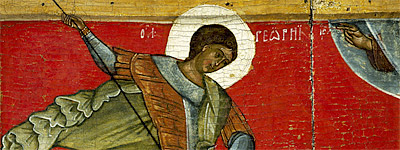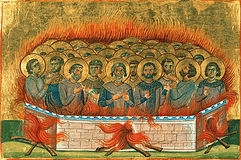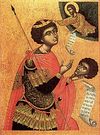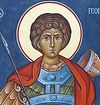

| Previous day | Next day |
| Old Style
November 3
|
Saturday |
New Style
November 16
|
| 21st Week after Pentecost. Tone 3. | No fast.
|
![]() Hieromartyrs Acepsimas, bishop, the priest Joseph, and the deacon Aeithalas, of Persia (376).
Hieromartyrs Acepsimas, bishop, the priest Joseph, and the deacon Aeithalas, of Persia (376). ![]() Dedication of the Church of the Great-martyr George in Lydda (4th c.).
Dedication of the Church of the Great-martyr George in Lydda (4th c.).
Martyrs Atticus, Agapius, Eudoxius, Carterius, Istucarius (Styrax), Pactobius (Tobias), Nictopolion, and companions, at Sebaste (320). St. Acepsimas, hermit, of Cyrrhus in Syria (4th c.). St. Snandulia of Persia (380). St. Anna, daughter of Prince Vsevolod I Yaroslavich (1112).
New Hieromartyrs Nicholas Dinariev, archpriest, of Danevo (Ryazan) (1918); Paul Andreyev and Alexander Zverev, archpriests, of Vozmishche (Moscow), Sergius Kedrov, archpriest, of Faustovo (Moscow), Alexander Parusnikov, archpriest, of Ramenskoye (Moscow), Vladimir Pisarev, archpriest, of Kostino (Moscow), and Vincent Smirnov, archpriest, of Khimki (Moscow) (1937).
St. Achaemonides (or Hormisdas), confessor, of Persia (4th c.). St. Winifred of Holywell, Wales (630). St. Hubert, bishop of Liege (727). St. Pirmin, bishop and monastic founder (Germany) (753). St. Theodore, confessor, bishop of Ancyra (8th-9th c.). The Meeting [1196] of St. Sava [1235] and St. Symeon the Myrrh-gusher [1200], of Serbia, at Vatopedi [Mt. Athos]. St. Nicholas of Iveron (Mt. Athos) and Georgia, hymnographer (1308). St. Pimen, monk of Zographou (Mt. Athos) (1610). New Hieromartyr George, priest, of Neopolis, Asia Minor (1797).
Thoughts for Each Day of the Year
According to the Daily Church Readings from the Word of God
By St. Theophan the Recluse

Saturday. [II Cor. 11:1-6; Luke 9:1-6]
And he sent them (the holy apostles) to preach the Kingdom of God. Then only throughout Palestine, but later throughout the whole world. The preaching which was begun then has not ended to this day. Every day we hear what has been handed down by the holy Apostles from the the Lord, in the holy Gospels and the Apostolic writings. Time does not make a difference: we hear the holy Apostles and the Lord Himself as if they were before us, and the power which acted in them acts to this day in the Church of God. The Lord has not deprived any believers of anything: what the first ones had, the most recent ones have as well. Faith has always encompassed this, and still does. But false wisdom came and made a division between the present and what was originally. It seemed to this false wisdom that there was a great gulf between them; its head began to spin, its eyes grew dim, and for it, the Lord and holy Apostles were as if plunged into a seemingly impenetrable darkness. And it gets what it deserves: let it reap the fruits of what it has sown; only the downfall of the spirit is in it. It wallows in darkness and it does not see the light, and one can only acknowledge this consciousness as being sincere—but who is guilty? It has fogged itself over and continues to do so. To this day, it has not stated why one could not consider the words of New Testament Scripture to be the true word of the holy Apostles and of the Lord Himself. It only cries out tirelessly: “I do not see, I do not see.” We believe, we believe, that you do not see! But stop emitting your fog—the air around you will clear, and then perhaps God’s light will come in and you will see something. “But this is the same as me ceasing to be myself.” Too bad! Stop; others will have more peace. “No, I cannot. I am destined to exist until the end of the age, and very artful ones will arise. I began in the first creature’s mind, even before this visible world [came into being], and while the world still stands, I will rip like a whirlwind across the paths of truth to raise up a pillar of dust against it.” But, you see, you only fog yourself, while around you it is light. “No, I will dust at least someone’s eyes; and if not, let them know me as I am. I will not be silent, and you with your truth will never manage to bar my lips.” Who does not know this? Everyone knows that your first title is “pizma” (from the Greek)—obstinately insisting on your own way, regardless of all obviousness which unmasks your falseness. You are blasphemy against the Holy Spirit—so await the fulfilment of the sentence pronounced against you by the Lord.
Articles
 Martyr Aithalas of PersiaThe Holy Martyr Aithalas the Deacon, by order of the Persian emperor Sapor II, was put to death by stoning in the year 380 for confessing Christ. |
 Great Martyr George |
 Venerable Akepsimas the Hermit of Cyrrhus in SyriaSaint Akepsimas, Hermit of Cyrrhus in Syria lived for sixty years in the desert, not far from Cairo. |
 Saint Snandulia of PersiaSnandulia was a devout Christian of the city of Arbela who visited those who suffered in prison for the sake of Christ. |









